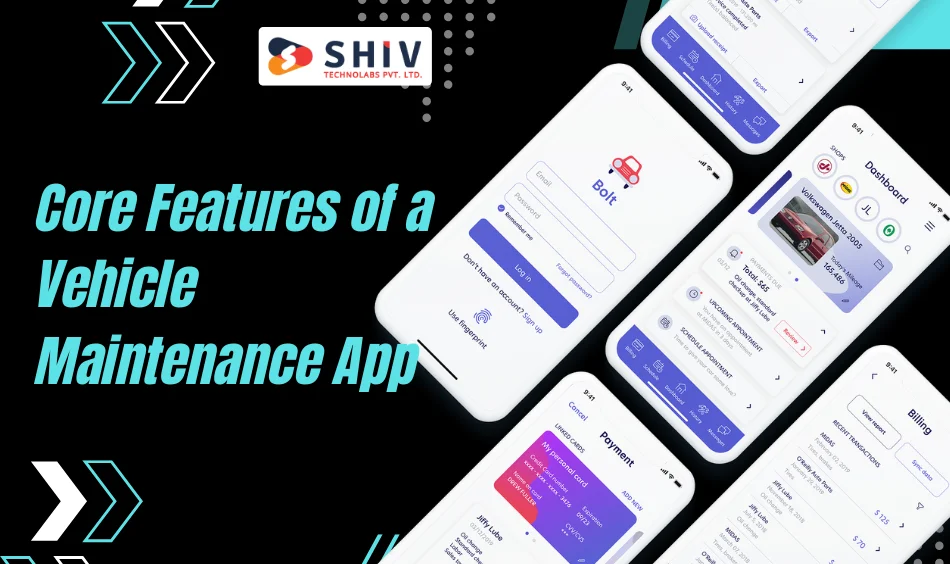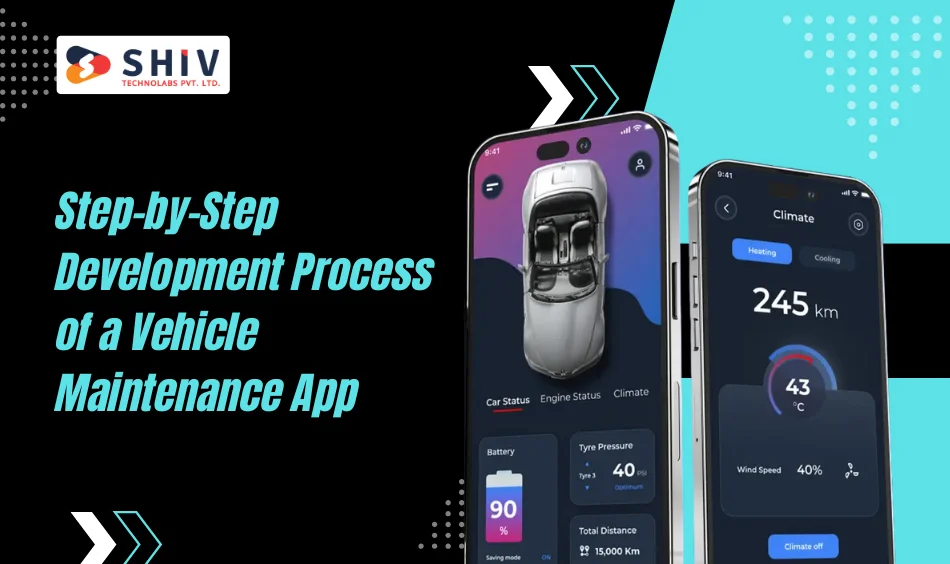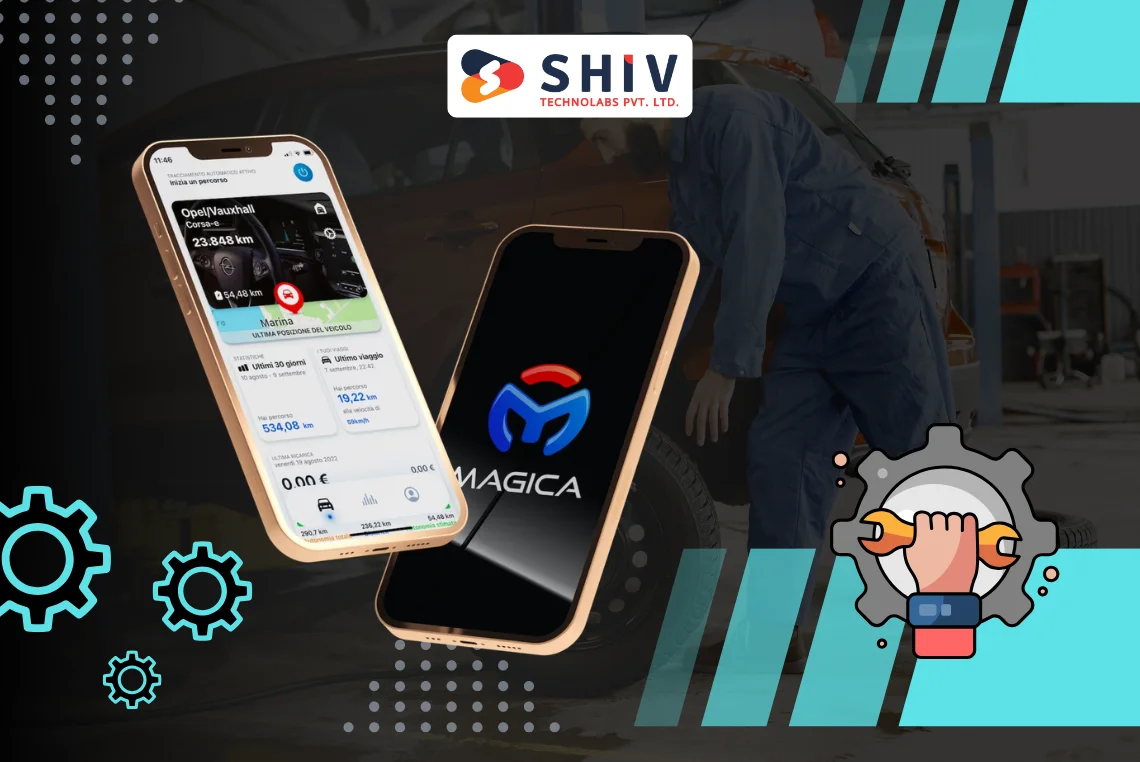Table of Contents
Not long ago, people used to scribble down oil change dates or just try to remember them. These days, that’s rare. Most drivers now reach for their phones when it comes to keeping their vehicles in shape. Whether it’s a reminder for a tire check or a place to track repairs, mobile apps are quickly replacing manual methods.
Cars are also getting smarter. With built-in sensors and constant connectivity, they’re giving apps more data to work with—like mileage, engine health, and more. No surprise, then, the auto software space is picking up fast. Some reports say it could go past $50 billion by 2027.
That shift isn’t just exciting—it’s also a real chance for developers to build something useful while the market’s still growing.
Also Read: Car Wash App Development
What Is a Vehicle Maintenance App?
A vehicle maintenance app is a mobile tool that helps individuals or businesses keep track of their car’s service needs. It stores vehicle details and reminds users about regular maintenance such as oil changes, tire rotations, and battery checks.
The app can support:
- Personal car tracking for daily drivers
- Fleet management for logistics or delivery companies
- Service scheduling with local garages or workshops
With these apps, users don’t need to remember dates or manually track vehicle health. Everything is handled through notifications, logs, and easy-to-use dashboards.
Core Features of a Vehicle Maintenance App

For an app like this to be useful, it needs to handle real-world needs simply. These are the key features most drivers or fleet owners expect.
# Vehicle Profile Management
- Let users add more than one car under the same account.
- Basic info like make, model, and VIN is a must.
- A place to store things like a photo or a scanned registration can come in handy, too.
# Maintenance Reminders
- People forget. The app shouldn’t.
- Set reminders based on mileage or time for things like oil changes, battery checks, and tire rotations.
- Keep it flexible so users can choose how they want to be reminded.
# Service History Logs
- A simple record of what’s been done, when, and how much it cost.
- Include space for extra notes—garage name, mechanic feedback, anything the user wants to remember.
# Fuel Tracker
- Let users log each fill-up with the odometer reading and price.
- Helpful for watching fuel efficiency over time or spotting sudden drops in mileage.
# Document Storage
- One place to keep important paperwork—insurance, emission test, warranty info.
- Set expiry alerts so nothing gets missed.
# Notifications That Matter
- No one wants spam, but a heads-up about an upcoming service? Always welcome.
- Give options for push, email, or in-app alerts.
# Dashboard and Reports
- A clear overview at a glance: what’s coming up, what’s been done, and how much has been spent.
- Don’t overcomplicate it—just give people what they need to stay in control.
- list 3
Check out here car parking application development services
Advanced Features in a Vehicle Maintenance App
Once you’ve covered the basics, it’s the advanced features that set your app apart. These additions can make a huge difference, especially for people who manage fleets or just want more control over how their vehicles are handled.
# AI-Based Predictive Maintenance
- Based on how the vehicle’s being used, the app can catch patterns and flag issues early
- Instead of waiting for a breakdown, it suggests service when it sees signs of wear
# Service Center Bookings
- Finding a nearby workshop and setting up an appointment should take just a few taps
- The mechanic can also view the car’s service record if shared through the app
# Real-Time GPS and Mileage Tracking
- Trips and mileage are logged automatically using GPS or data pulled from the vehicle
- It takes one more task off the user’s list
# Sync Across Devices
- If someone logs a repair on their phone, they should be able to open it later on a tablet
- This is especially helpful for teams or households sharing responsibility
# Live Sensor Readings from the Vehicle
- With access to the car’s onboard systems, the app can read things like tire pressure or battery levels
- If something looks wrong, the app gives a heads-up before it becomes serious
# Driver Behavior Tracking
- Whether it’s sudden braking, fast turns, or long idling, these patterns are logged
- Fleet owners can use this to keep vehicles in better condition
# Voice Input
- Typing isn’t always convenient. Saying “log oil change” is faster and more natural
- Voice input helps users manage entries when they’re in a rush
# Built-in Chat Support
- If someone’s not sure where to find a document or what a warning means, chat can help
- A support window inside the app saves time and avoids frustration
# Multi-Language Setup
- Not every user will prefer English. The app should feel comfortable to anyone using it
- Supporting multiple languages helps expand your audience
# Detailed Expense Insights
- Break down costs across categories like fuel, repairs, or general maintenance
- Give users a way to spot trends and see where the money goes month to month
Step-by-Step Development Process of a Vehicle Maintenance App

Here’s a breakdown of the process of a real-world vehicle maintenance app — not just in theory, but in action.
# Requirement Discovery & User Flow Planning
- First, define the target audience: personal drivers, fleet managers, or garages.
- Prepare detailed user stories like “John wants to log fuel expenses monthly” or “Lisa needs to track 3 vehicles in one account.”
- Design user flow diagrams showing how users move through the app, from registration to setting reminders.
# UI/UX Design (Wireframes + High-Fidelity Mockups)
- Create wireframes for every core screen (vehicle profile, reminders, dashboard).
- Then design high-fidelity mockups in tools like Figma or Adobe XD, focusing on usability with large buttons, minimal screens, and intuitive layouts.
- Include dark/light mode options for better user comfort.
# Backend Stack Planning & Architecture
- Choose tech stack: Node.js or Python (Django) for backend, with PostgreSQL or MongoDB as the database.
- Prepare a scalable API architecture to handle different modules: fuel logs, service logs, notifications, etc.
- Use JWT or OAuth2 for secure login/authentication.
# Frontend & Mobile App Development
- Develop for Android (Kotlin) and iOS (Swift) or use Flutter/React Native for a cross-platform solution.
- Focus on loading speed and responsiveness while developing the mobile app.
- Integrate features such as barcode scanners for VIN input and voice notes for service entries.
# Third-Party Integration
- Google Maps (for nearby service centers)
- Push notification service (Firebase or OneSignal)
- Cloud storage (AWS S3 or Firebase)
- Optional: OBD-II integration or connected car APIs
# Testing and Pre-Launch
- Write automated test cases for each feature.
- Run manual testing on real devices (multiple screen sizes and OS versions).
- Conduct a beta test with 20–50 users before final release.
# App Store Launch & Support
- Prepare ASO-friendly content (app description, screenshots).
- Submit to the Apple App Store and Google Play.
- Plan first update 30–45 days after launch to fix bugs and apply user feedback.
Cost to Build a Vehicle Maintenance App
Below is a practical breakdown of the estimated development costs of a vehicle maintenance app, based on three different app types. Each tier includes details of what’s included.
| App Type | Estimated Cost (USD) | Key Features Included |
|---|---|---|
| Basic App | $8,000 – $12,000 | – Vehicle profiles – Service reminders – Fuel tracking – Document uploads – Basic dashboard |
| Mid-Level App | $15,000 – $25,000 | – All basic features – Multi-vehicle support – Cloud sync – Expense reports – Appointment bookings |
| Advanced App | $30,000 – $50,000+ | – All mid-level features – Real-time GPS tracking – Driving behavior insights – Voice input – Admin dashboard for fleets |
Note: The final cost may change based on the number of screens, tech stack, maintenance needs, and whether you build for one platform or both (iOS + Android).
Why Choose Shiv Technolabs for Vehicle Maintenance App Development
At Shiv Technolabs, we design mobile apps that solve real problems. Our team builds vehicle maintenance apps tailored to your business needs, whether you manage a fleet or want to serve car owners.
We focus on:
- Clear communication from idea to launch
- User-friendly app design
- Fast development timelines
- Full support after launch
You get the best mobile app development services in USA, from planning and design to testing and publishing. We also offer long-term maintenance and custom features if you want to grow the app later.
Want to turn your idea into a working app? Our developers are ready to help.
Conclusion
A vehicle maintenance app is no longer a luxury — it’s becoming a must-have tool for drivers and service providers. With the right set of features and a well-planned development process, you can build an app that keeps users engaged and cars in good condition.
Whether you’re starting small or planning a large-scale solution, take time to define your goals and pick the right tech team. In the years ahead, vehicle apps will continue to evolve with connected cars, smart diagnostics, and voice commands. Starting now means you’ll be ready for that future.
Have an idea or need help building your vehicle maintenance app? Reach out to us—we’re here to make it happen.
























